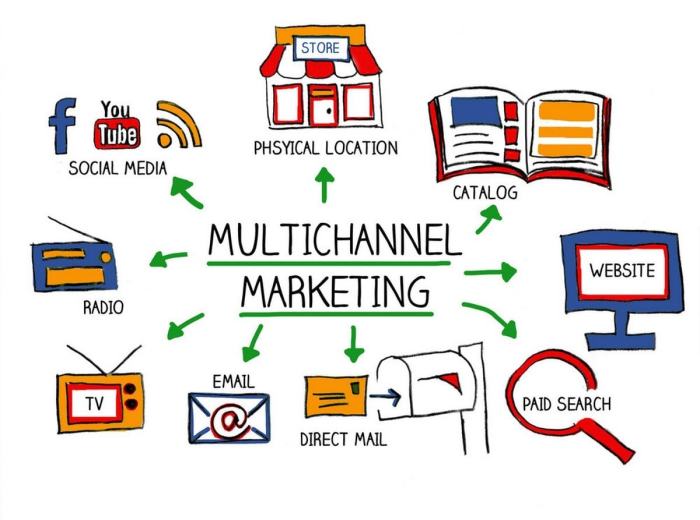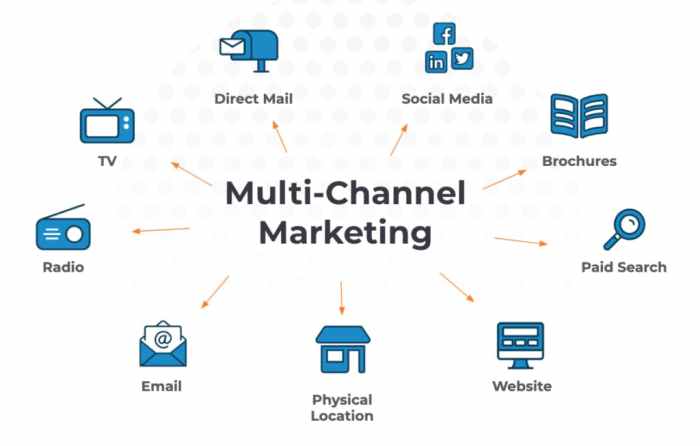Multi-Channel Marketing isn’t just a buzzword—it’s a game-changer. Get ready to dive into a world where brands connect with customers like never before, all while boosting engagement and sales.
In today’s digital landscape, reaching consumers through various channels is crucial for success. This comprehensive guide delves into the intricacies of Multi-Channel Marketing and how it can transform your business.
Definition of Multi-Channel Marketing
Multi-channel marketing is a strategy where a company uses multiple channels to reach and interact with customers. These channels can include online platforms, social media, email, physical stores, and more. The key aspect of multi-channel marketing is providing a seamless experience for customers across all these channels.
Difference from Omni-Channel Marketing
In multi-channel marketing, the focus is on using various channels to reach customers, while omni-channel marketing goes a step further by integrating all these channels to provide a unified and consistent experience for customers. Omni-channel marketing aims to create a seamless journey for customers as they move between different channels.
Examples of Multi-Channel Marketing Strategies
- Launching a product through a combination of online ads, social media promotions, and in-store events
- Offering customers the option to purchase online, in-store, or through a mobile app
- Sending personalized email campaigns with links to social media pages for engagement
Importance of Integrating Different Channels
Integrating different channels in multi-channel marketing is crucial for providing a cohesive and unified experience for customers. By ensuring that all channels work together seamlessly, companies can create a more engaging and personalized journey for customers. This integration also allows companies to track customer interactions across channels and optimize their marketing strategies for better results.
Benefits of Multi-Channel Marketing

Multi-channel marketing offers a range of benefits that can significantly impact a business’s success. By utilizing various channels to reach customers, companies can enhance their marketing efforts and achieve better results.
Enhanced Customer Engagement and Brand Visibility
Multi-channel marketing allows businesses to interact with customers through different platforms, such as social media, email, websites, and physical stores. This increased presence helps to improve brand visibility and creates more opportunities for engagement. Customers are more likely to notice and remember a brand that they encounter across multiple channels, leading to stronger connections and loyalty.
Increased Sales and ROI
Through multi-channel marketing, businesses can reach a wider audience and target customers at different stages of the buying journey. This targeted approach can result in higher conversion rates and increased sales. Additionally, by analyzing data from various channels, companies can gain valuable insights into customer behavior and preferences, allowing them to optimize their marketing strategies for better results. Ultimately, this can lead to a higher return on investment (ROI) for businesses implementing multi-channel marketing strategies.
Hey there! Ever thought about writing video scripts for marketing? It’s a cool way to grab people’s attention and promote your brand. Check out this awesome guide on Writing Video Scripts for Marketing to learn some tips and tricks. Who knows, you might just be the next big thing in the advertising world!
Popular Multi-Channel Marketing Channels

When it comes to multi-channel marketing, businesses have a variety of channels to choose from in order to reach their target audience effectively. Let’s take a look at some of the most popular channels used in multi-channel marketing:
Social Media
Social media platforms like Facebook, Instagram, Twitter, and LinkedIn provide businesses with the opportunity to engage with their audience in real-time, share content, run ads, and build brand awareness.
Yo, writing video scripts for marketing is key to reaching your audience in a fresh and engaging way. Check out this dope guide on Writing Video Scripts for Marketing for some killer tips to make your content pop!
- Strengths: High engagement levels, ability to target specific demographics, shareability of content.
- Weaknesses: Constant algorithm changes, saturation of content, need for active management.
One successful multi-channel campaign that leveraged social media effectively is Starbucks’ #RedCupContest, which encouraged customers to share photos of their festive drinks on social media for a chance to win prizes.
Email marketing remains a staple in multi-channel strategies, allowing businesses to communicate directly with their audience through personalized messages, promotions, and updates.
- Strengths: Direct communication, high ROI, ability to segment and target specific audiences.
- Weaknesses: Risk of ending up in spam folders, email fatigue, compliance with regulations like GDPR.
An example of a successful multi-channel campaign that utilized email marketing effectively is Airbnb’s personalized email campaigns that provide tailored recommendations based on user preferences and behaviors.
Websites
A business’s website serves as the central hub for its online presence, providing information, products, and services to visitors. Optimizing websites for user experience and is crucial in a multi-channel strategy.
- Strengths: Control over branding and messaging, ability to track user behavior, conversion optimization.
- Weaknesses: Dependent on website traffic, maintenance costs, competition for visibility.
A successful multi-channel campaign that integrated websites effectively is Nike’s “Just Do It” campaign, which included a website hub featuring inspiring stories, product information, and social media integration.
Mobile Apps, Multi-Channel Marketing
Mobile apps offer businesses a direct channel to engage with customers, provide personalized experiences, and drive conversions through push notifications, in-app messaging, and loyalty programs.
- Strengths: Enhanced user experience, convenience, ability to leverage location-based services.
- Weaknesses: Development and maintenance costs, app store visibility, user retention.
An example of a successful multi-channel campaign that utilized mobile apps effectively is Starbucks’ mobile app, which allows customers to order ahead, earn rewards, and receive personalized offers based on their purchase history and preferences.
Challenges of Implementing Multi-Channel Marketing
Implementing multi-channel marketing strategies can pose several challenges for businesses. One of the main difficulties is maintaining consistency across different channels while still adapting to the unique features of each platform. This can lead to issues with messaging, branding, and overall customer experience.
Overcoming Challenges in Multi-Channel Marketing
- Develop a cohesive strategy: Ensure that your marketing efforts are aligned across all channels to provide a seamless experience for customers.
- Utilize technology: Invest in tools and platforms that can help you manage and track your multi-channel campaigns effectively.
- Train your team: Provide training to your employees to ensure they understand the importance of consistency and how to implement it across various channels.
- Monitor and analyze results: Regularly review the performance of your multi-channel marketing campaigns to identify any inconsistencies and make necessary adjustments.
Impact of Inconsistent Messaging
Inconsistent messaging or branding across different channels can confuse customers and weaken your brand identity. It can lead to a lack of trust and credibility, ultimately resulting in decreased engagement and conversions. Therefore, it is crucial to maintain a consistent voice, tone, and messaging across all channels to build a strong and recognizable brand presence.
Measurement and Analytics in Multi-Channel Marketing
In the realm of multi-channel marketing, tracking and analyzing data from various channels is essential for understanding the effectiveness of campaigns and making informed decisions.
Key Performance Indicators (KPIs) for Multi-Channel Campaigns
- Conversion Rate: measuring the percentage of visitors who take a desired action on the website.
- Customer Acquisition Cost (CAC): determining the cost of acquiring a new customer through different channels.
- Customer Lifetime Value (CLV): evaluating the total revenue generated by a customer over their lifetime.
- Return on Investment (ROI): calculating the profitability of marketing campaigns across different channels.
Optimizing Multi-Channel Marketing Efforts with Analytics
Utilizing analytics allows businesses to gain valuable insights into customer behavior, preferences, and interactions across multiple channels. By analyzing data, businesses can identify trends, optimize campaigns, and allocate resources more effectively to enhance overall marketing performance.
